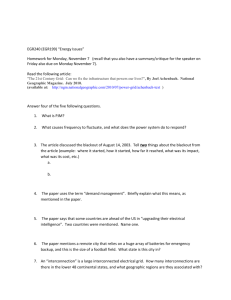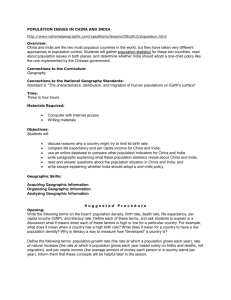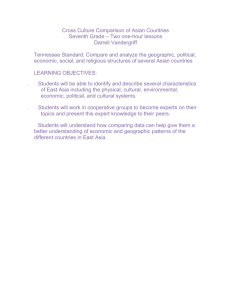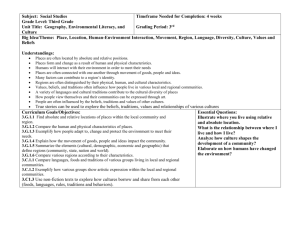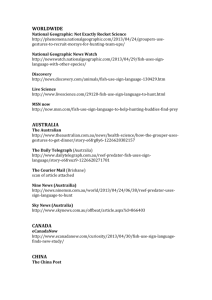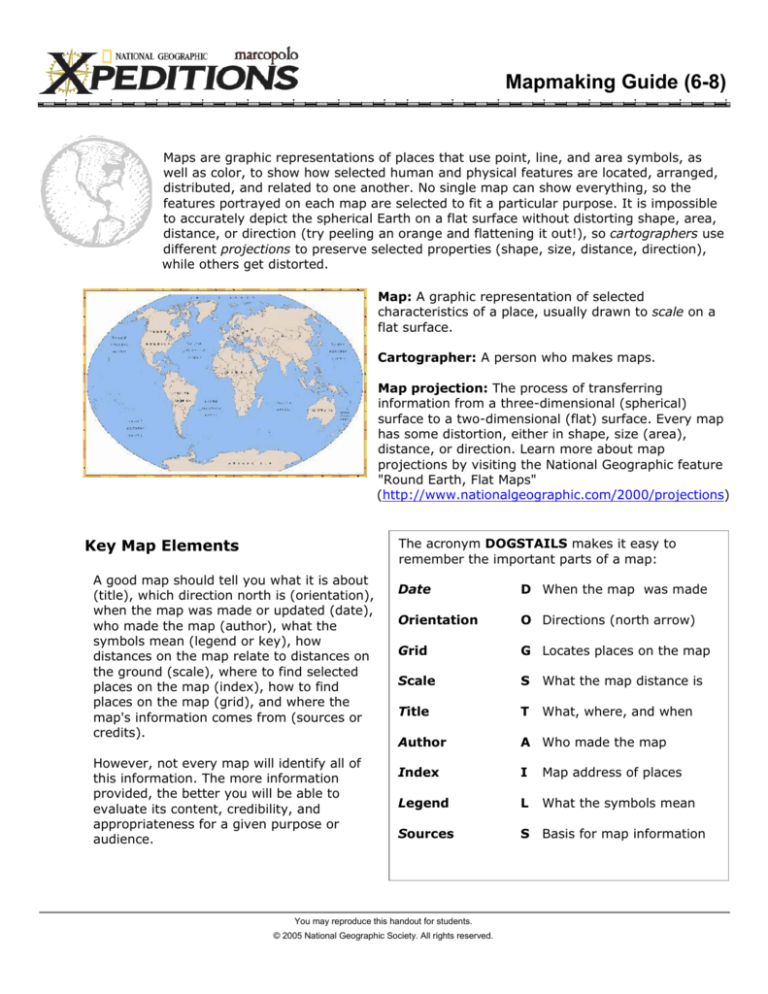
Mapmaking Guide (6-8)
Maps are graphic representations of places that use point, line, and area symbols, as
well as color, to show how selected human and physical features are located, arranged,
distributed, and related to one another. No single map can show everything, so the
features portrayed on each map are selected to fit a particular purpose. It is impossible
to accurately depict the spherical Earth on a flat surface without distorting shape, area,
distance, or direction (try peeling an orange and flattening it out!), so cartographers use
different projections to preserve selected properties (shape, size, distance, direction),
while others get distorted.
Map: A graphic representation of selected
characteristics of a place, usually drawn to scale on a
flat surface.
Cartographer: A person who makes maps.
Map projection: The process of transferring
information from a three-dimensional (spherical)
surface to a two-dimensional (flat) surface. Every map
has some distortion, either in shape, size (area),
distance, or direction. Learn more about map
projections by visiting the National Geographic feature
"Round Earth, Flat Maps"
(http://www.nationalgeographic.com/2000/projections)
Key Map Elements
The acronym DOGSTAILS makes it easy to
remember the important parts of a map:
A good map should tell you what it is about
(title), which direction north is (orientation),
when the map was made or updated (date),
who made the map (author), what the
symbols mean (legend or key), how
distances on the map relate to distances on
the ground (scale), where to find selected
places on the map (index), how to find
places on the map (grid), and where the
map's information comes from (sources or
credits).
However, not every map will identify all of
this information. The more information
provided, the better you will be able to
evaluate its content, credibility, and
appropriateness for a given purpose or
audience.
Date
D When the map was made
Orientation
O Directions (north arrow)
Grid
G Locates places on the map
Scale
S
What the map distance is
Title
T
What, where, and when
Author
A Who made the map
Index
I
Map address of places
Legend
L
What the symbols mean
Sources
S
Basis for map information
You may reproduce this handout for students.
© 2005 National Geographic Society. All rights reserved.
Page 2 of 8
Mapmaking Guide (6-8)
You may also have heard the acronym TODALSIGs, which lists the map elements in order of
importance.
Title: Text explaining what the map is supposed to portray: what is happening, where, and
when.
Orientation: In most cases, the direction “north” is assumed to be at the top
of a map. A north arrow is a symbol indicating the direction in which north
lies; a compass rose is a symbol indicating the cardinal directions (N, S, E,
W) and sometimes intermediate directions (NE, NW, SE, SW).
Date: Text identifying when the map was made and/or updated.
Author: Text identifying the cartographer or organization responsible for making the map.
Legend or Key: A guide identifying what the map’s symbols and colors represent.
Scale: The relationship between distance on a map and actual distance on the earth. Scale
may be represented by words (e.g., “one inch equals one mile”), a ratio or fraction (e.g.,
1:63,360), or a divided bar. Bar scale is best to use when enlarging or reducing the size of a
map, since the scale size will change with the map size. A map showing a small area in detail
(such as a street map of a neighborhood) is a “large scale” map, while a map showing a
large area without much detail (such as the world or a continent) is a “small scale” map
(think about fractions here!).
Types of Scale
Verbal
Number
Graphic
words
ratio or fraction
divided bar or line (like a
ruler), usually showing miles
or kilometers
one inch equals one mile
1:63,360
Index: A listing of the places on the map and where to find them using grid coordinates—
either latitude-longitude (77°53’W, 38°02’N) or letter-number (B4).
Grid: Intersecting lines (called a “coordinate
system”) drawn on a map to pinpoint location.
The grid can be a simple set of intersecting
perpendicular lines identifying rows and columns
with letters and numbers (often used on a street
map) or a set of intersecting lines identifying
selected latitudes and longitudes (often used on
topographic or world maps).
www.nationalgeographic.com/xpeditions
© 2005 National Geographic Society. All rights reserved.
Page 3 of 8
Mapmaking Guide (6-8)
Latitude and longitude are imaginary lines encircling the globe, intersecting each other to
form a grid that helps us pinpoint location—our "global address." They are measured in terms
of the 360 degrees of a circle, sub-divided into minutes and seconds. For example, the White
House in Washington, DC is located at 38°53'51"N, 77°02'11"W—that means it is 38 degrees,
53 minutes, 77 seconds north of the equator, and 77 degrees, 2 minutes, 11 seconds west of
the Prime Meridian.
Latitude lines (also called "parallels") run east-west, parallel to the Equator and
measure distance north and south, from 0 degrees at the Equator to 90 degrees at the
North and South Poles.
Longitude lines (also called "meridians") run north-south and meet at the poles,
measuring distance east and west of the Prime Meridian, from 0 degrees at the Prime
Meridian running through Greenwich, England, to 180 degrees at the International
Date Line (mostly in the Pacific Ocean).
Sources: Text identifying where the map’s information comes from (like a bibliography for
the map).
Additional Map Elements
The following features may or may not be present on a given map:
Neat line: A box drawn around the map to give a “neat,” or tidy, appearance to the product.
Insets: Additional, smaller maps set within the larger main map.
Graphs: Pictorial representations of numeric data, often used as an additional method of
displaying the data represented on the map. Line graphs, bar graphs, and pie charts are
common types.
Timelines: Text and graphics arranged sequentially along a line to give information about
when events or phenomena occurred. Timelines are sometimes used on maps to give a
better idea of how time relates to the data or theme represented.
Explanatory Text: Text that is not part of the map’s title, legend, or credits, used to give the
map reader a deeper understanding of the map, its data, and/or its theme.
Credits: Text that may include sources, author, photographers, individuals, or organizations
involved in creating the map or its contents.
www.nationalgeographic.com/xpeditions
© 2005 National Geographic Society. All rights reserved.
Page 4 of 8
Mapmaking Guide (6-8)
Basic Issues in Map Design
1. Considering the purpose of and audience for the map:
One of a cartographer’s first steps is to identify the purpose and audience of the map. The
purpose and audience determine how data are displayed, what map elements are
included, and the general layout and format of the entire map. A map designed to be a
teaching tool for third graders will obviously look different than a map designed to be
included in a report for senators.
2. Choosing a map type:
Once cartographers know what they want to show on a map, they must decide which map
type (reference or thematic) will be most effective in communicating the map’s purpose to
its readers. The type of data, audience, and geographic area represented are some of the
factors that affect this decision. See section on “Types of Maps” below for more
information.
3. Selecting a title that represents what is shown
Choosing a title for a map is an important part of the cartographic process. The title of the
map should tell map readers, in a few words, what is important about the map. Some map
titles simply state the information portrayed (e.g., “Percentages of Global Indigenous
Languages”), while other titles engage map readers with a broader, catchier phrase (e.g.,
“Voices of the World”).
4. Selecting and placing text
Placing text on a map is a particularly difficult challenge to the cartographer. Text must be
placed so that it is readable and easily located but also must not interfere with the map’s
data or design. Different font types, styles, sizes, and colors can be used to establish clear
association between text and map features.
5. Designing an overall layout for easy understanding
As in any form of graphic art, cartographers have to consider the layout of all map
elements to create a final product that is informative, accurate, and aesthetically pleasing.
Visual balance is always an important consideration for design.
Types of Maps
There are two main types of maps, based on their design purpose. Reference (or general
purpose) maps depict selected details of the physical and human-made environment as
accurately as possible. Thematic (or special purpose) maps depict the general spatial
pattern of selected features or data.
www.nationalgeographic.com/xpeditions
© 2005 National Geographic Society. All rights reserved.
Page 5 of 8
Mapmaking Guide (6-8)
Reference (General Purpose) Maps
Reference (also called general purpose) maps depict selected features of the physical and
human-made environment. Reference maps use symbols to locate and identify important
landmarks and geographic features. Examples include road maps, classroom wall maps,
political maps, physical maps, and topographic maps.
Political maps are reference maps that
show names and boundaries of political
geographic units (states, countries, etc.)
and only very important physical or
human features (e.g., rivers, highways,
etc.)
Physical maps use shaded or painted
relief to illustrate the major landforms
(natural features) of a region, country,
or world. Mountain ranges and rivers
usually are prominent features on such
maps; other features would include
deserts, glaciers, lakes, and valleys.
The colors on physical maps often
include brown or green for land and
blue for water.
Topographic maps are general reference maps showing coastlines, cities, and rivers that
use contour lines to show elevation differences. Such maps are helpful to hikers because they
can show elevation changes along a trail. Government agencies like the U.S. Geological
Survey (USGS) produce these maps that are often based on satellite data or aerial
photography.
Satellite maps are produced from data recorded by satellite sensors
and transmitted to Earth where computers process the data into images.
Satellites can provide map images of formerly inaccessible parts of our
world and of distant worlds—like Mars or the Moon.
www.nationalgeographic.com/xpeditions
© 2005 National Geographic Society. All rights reserved.
Page 6 of 8
Mapmaking Guide (6-8)
Thematic (Special Purpose) Maps
Thematic (also called special purpose) maps: Display distributions—or patterns—over
Earth's surface. Thematic maps emphasize some particular feature or set of data (such as
rainfall or locations of crops), using color, shading, or symbols to represent differences. For
example, census maps focus on population distribution as well as data on such items as age,
ethnicity, and income; these maps help governments provide services to its citizens and plan
for the future.
Thematic maps can portray data using shaded areas (choropleth), dots (dot-density), symbols
of different sizes (graduated symbol), lines of equal measurement (isoline), or proportional
size of area (cartogram).
Choropleth Maps use color shading to represent
different quantities or values. Darker colors usually
represent greater quantities or values, while lighter
colors usually represent smaller quantities or values.
Dot-density (also called dot) maps place individual
points on a map to correspond with occurrences of a
particular feature or data. Clusters of dots show where
the features or data are concentrated.
Graduated symbol maps use symbols of different
sizes placed within an area to show the value or
quantity associated with it. The symbol is often a
circle, but it may be one that relates to the map’s
theme (such as figures of people to represent
population data).
www.nationalgeographic.com/xpeditions
© 2005 National Geographic Society. All rights reserved.
Page 7 of 8
Mapmaking Guide (6-8)
Isoline (also called isopleth) maps use lines to
connect points of equal value, such as temperature,
rainfall, or elevation. Lines of equal temperature are
called isotherms, lines of equal rainfall are called
isohyets, and lines of equal elevation are called
contours. Contour lines are often used on topographic
maps.
Cartograms distort the size and shape of
map areas to show statistical data. For
example, a cartogram of world population
shows land area as proportional to
population size—although the United
States and China have similar land areas
(the U.S. is slightly larger), a population
cartogram would show China as much
larger than the U.S. because its population
is much larger.
Read Maps Can Tell a Migration Story: An Interview with National Geographic Cartographers
(http://www.nationalgeographic.com/xpeditions/activities/09/gamapinterview.pdf) to find out
about considerations cartographers make.
www.nationalgeographic.com/xpeditions
© 2005 National Geographic Society. All rights reserved.
Page 8 of 8
Mapmaking Guide (6-8)
Suggested Resources
National Geographic: Round Earth, Flat Maps
http://www.nationalgeographic.com/2000/projections/
National Geographic: MapMachine—View and Customize (click "What is a Satellite [or other
type, from drop-down box] Map" for pop-up box with definitions)
http://mapmachine.nationalgeographic.com/mapmachine/viewandcustomize.html
University of Texas Bureau of Economic Geology: Scale Calculator
http://www.beg.utexas.edu/GIS/tools/scale2.htm
National Geographic: Geography Standard 1—How to Use Maps and Other Geographic
Representations, Tools, and Technologies to Acquire, Process, and Report Information From a
Spatial Perspective
http://www.nationalgeographic.com/xpeditions/standards/01/index.html
National Geographic: Xpedition Hall—Globe Projector
http://www.nationalgeographic.com/xpeditions/hall/index.html?node=20
National Geographic: A World Distorted by AIDS (cartogram)
http://www7.nationalgeographic.com/ngm/0509/feature4/map.html
National Geographic: Xpeditions Activity—Crack the Code
http://www.nationalgeographic.com/xpeditions/activities/01/crackcode.html
National Geographic: Xpeditions Lesson Plan—Contour Maps With DOGSTAILS
http://www.nationalgeographic.com/xpeditions/lessons/01/g68/dogstails.html
National Geographic: Xpeditions Lesson Plan—Latitude, Longitude, and Mapmaking
http://www.nationalgeographic.com/xpeditions/lessons/01/g68/mapmaking.html
National Geographic: Xpeditions Lesson Plan—Mapping Mars
http://www.nationalgeographic.com/xpeditions/lessons/01/g68/marsmap.html
National Geographic: Xpeditions Lesson Plan—Map Projections
http://www.nationalgeographic.com/xpeditions/lessons/01/g912/projections.html
National Geographic: Xpeditions Lesson Plan—A Look at the Population Density of the United
States
http://www.nationalgeographic.com/xpeditions/lessons/01/g912/density.html
www.nationalgeographic.com/xpeditions
© 2005 National Geographic Society. All rights reserved.

